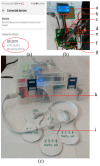IoT-Based Heartbeat Rate-Monitoring Device Powered by Harvested Kinetic Energy
- PMID: 39001027
- PMCID: PMC11243911
- DOI: 10.3390/s24134249
IoT-Based Heartbeat Rate-Monitoring Device Powered by Harvested Kinetic Energy
Abstract
Remote patient-monitoring systems are helpful since they can provide timely and effective healthcare facilities. Such online telemedicine is usually achieved with the help of sophisticated and advanced wearable sensor technologies. The modern type of wearable connected devices enable the monitoring of vital sign parameters such as: heart rate variability (HRV) also known as electrocardiogram (ECG), blood pressure (BLP), Respiratory rate and body temperature, blood pressure (BLP), respiratory rate, and body temperature. The ubiquitous problem of wearable devices is their power demand for signal transmission; such devices require frequent battery charging, which causes serious limitations to the continuous monitoring of vital data. To overcome this, the current study provides a primary report on collecting kinetic energy from daily human activities for monitoring vital human signs. The harvested energy is used to sustain the battery autonomy of wearable devices, which allows for a longer monitoring time of vital data. This study proposes a novel type of stress- or exercise-monitoring ECG device based on a microcontroller (PIC18F4550) and a Wi-Fi device (ESP8266), which is cost-effective and enables real-time monitoring of heart rate in the cloud during normal daily activities. In order to achieve both portability and maximum power, the harvester has a small structure and low friction. Neodymium magnets were chosen for their high magnetic strength, versatility, and compact size. Due to the non-linear magnetic force interaction of the magnets, the non-linear part of the dynamic equation has an inverse quadratic form. Electromechanical damping is considered in this study, and the quadratic non-linearity is approximated using MacLaurin expansion, which enables us to find the law of motion for general case studies using classical methods for dynamic equations and the suitable parameters for the harvester. The oscillations are enabled by applying an initial force, and there is a loss of energy due to the electromechanical damping. A typical numerical application is computed with Matlab 2015 software, and an ODE45 solver is used to verify the accuracy of the method.
Keywords: IoT server; Schenkel doubler; biomedical signal processing; electromagnetic energy harvester; kinetic energy harvesting; long-term ECG monitoring; quadratic non-linearity; wearable IoT devices.
Conflict of interest statement
The authors declare no conflicts of interest. The funders had no role in the design of the study; in the collection, analyses, or interpretation of data; in the writing of the manuscript; or in the decision to publish the results.
Figures














Similar articles
-
Self-Powered Multiparameter Health Sensor.IEEE J Biomed Health Inform. 2018 Jan;22(1):15-22. doi: 10.1109/JBHI.2017.2708041. Epub 2017 May 25. IEEE J Biomed Health Inform. 2018. PMID: 28574370
-
A Cloud Infrastructure for Health Monitoring in Emergency Response Scenarios.Sensors (Basel). 2024 Oct 30;24(21):6992. doi: 10.3390/s24216992. Sensors (Basel). 2024. PMID: 39517887 Free PMC article.
-
A Narrowband IoT Personal Sensor for Long-Term Heart Rate Monitoring and Atrial Fibrillation Detection.Sensors (Basel). 2024 Jul 9;24(14):4432. doi: 10.3390/s24144432. Sensors (Basel). 2024. PMID: 39065829 Free PMC article.
-
Wearable Technology for Monitoring Electrocardiograms (ECGs) in Adults: A Scoping Review.Sensors (Basel). 2024 Feb 18;24(4):1318. doi: 10.3390/s24041318. Sensors (Basel). 2024. PMID: 38400474 Free PMC article.
-
Overview of Respiratory Sensor Solutions to Support Patient Diagnosis and Monitoring.Sensors (Basel). 2025 Feb 11;25(4):1078. doi: 10.3390/s25041078. Sensors (Basel). 2025. PMID: 40006307 Free PMC article. Review.
References
-
- Cosoli G., Spinsante S., Scardulla F., D’Acquisto L., Scalise L. Wireless ECG and cardiac monitoring systems: State of the art, available commercial devices and useful electronic components. Measurement. 2021;177:109243. doi: 10.1016/j.measurement.2021.109243. - DOI
-
- Hooshmand M., Zordan D., Del Testa D., Grisan E., Rossi M. Boosting the Battery Life of Wearables for health monitoring through the compression of Biosignals. IEEE Internet Things J. 2017;4:1647–1662. doi: 10.1109/JIOT.2017.2689164. - DOI
-
- Shankara R., Murthy I.S.N. ECG Data compression Using Fourier Descriptors. IEEE Trans. Biomed. Eng. 1996;33:428–434. - PubMed
-
- Lee H., Buckley K.M. ECG Data Compression Using Cut and Align Beats Approch and 2-D Transforms. IEEE Trans. Biomed. Eng. 1999;46:556–564. - PubMed
MeSH terms
Grants and funding
LinkOut - more resources
Full Text Sources

